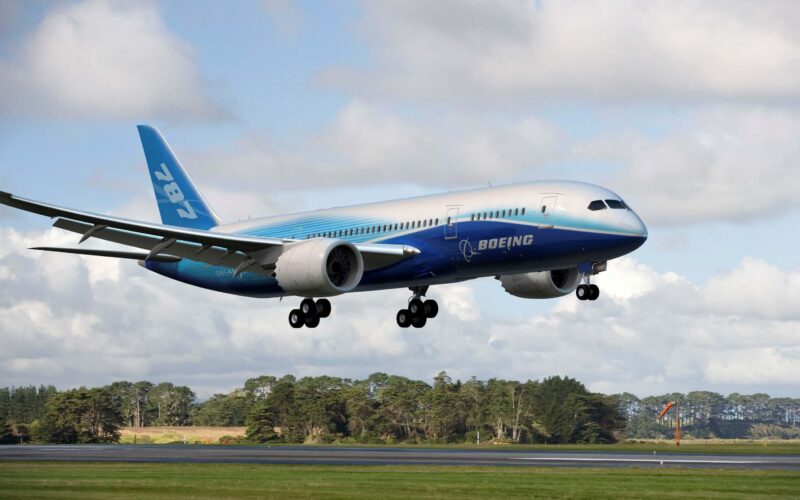Since its unveiling, the Boeing 787 Dreamliner has become a staple aircraft in long-haul aviation. The Dreamliner showcased that the future of air travel could be more efficient and beneficial for airlines.
It has been 12 years since the first Boeing 787 Dreamliner took to the skies for its flight test. To mark the occasion, AeroTime looks at the history and development of the popular widebody.
History in short: from development to entry into service
Development of the 787 Dreamliner began in the early 2000s when sales of Boeing’s older generation aircraft, namely the Boeing 767 and Boeing 747, started to progressively decline.
The early 2000s was a challenging period for the global airline market. The industry was disrupted by the September 11, 2001, attacks, which were followed by an increase in petroleum prices. The new challenges forced airlines to turn their attention to aircraft efficiency and reduced operating costs rather than size or speed.
On January 29, 2003, Boeing officially announced the name of a new mid-sized aircraft and released the first picture of the aircraft concept. The aircraft was named Boeing 7E7 and the letter E stood for “efficiency, economics, environmental performance, exceptional comfort and convenience, and e-enabled systems”.
The Boeing 7E7 aircraft, which was later renamed the 787 Dreamliner, was designed to target the 200 to 250-seat market, and provide non-stop, point-to-point service at speeds similar to its popular predecessors, the Boeing 777 and 747. Unlike other aircraft to be debuted in the early 2000s, including the Boeing 747-8i and the Airbus A380, the 787 Dreamliner’s strong point was not its size, but its performance.
The Dreamliner was built with composite materials, including carbon-fiber to make the aircraft lighter. It features efficient engines such as a Rolls-Royce Trent 1000 and General Electric GEnx 1B that gives it an extended range with reduced fuel consumption.
Boeing expected to offer the new airplane to airlines in early 2004, with entry into service targeted for 2008. However, it took longer than expected. Due to supply issues, a myriad of delays followed and Boeing’s first Dreamliner took to the skies for its flight test on December 15, 2009.
The three-hour long test flight was operated by 787 Chief Pilot Mike Carriker and Captain Randy Nevill.
Two years later, in 2011, the aircraft, painted in Japan’s All Nippon Airways (ANA) colors, finally entered commercial service.
After the aircraft’s successful entry into service, Boeing started to develop stretched versions of the 787 Dreamliner. The new 787-9 variant took flight on September 17, 2013, launching a comprehensive flight-test program leading to certification and the first delivery to its launch customer, Air New Zealand, in 2014.
The 787-8 Dreamliner can accommodate 210 to 250 passengers on routes of 7,650 to 8,200 nautical miles (14,167 to 15,186 kilometers), while the larger 787-9 Dreamliner has a capability to carry 250 to 290 passengers on routes of 8,000 to 8,500 nautical miles (14,816 to 15,742 kilometers).
The third member of the 787 Dreamliner family, the 787-10 version, was launched during the 2013 Paris Air Show. Five years later in 2018, the largest version of the 787 family was certified to enter commercial service. The 787-10 Dreamliner was first delivered to Singapore Airlines (SIA1) (SINGY).
The 787-10 Dreamliner is designed to fly up to 7,000 nautical miles (12,964 kilometers) and can carry 300 to 330 passengers depending on the airline’s configuration choices.
According to Boeing orders and deliveries, Boeing has delivered a total of 1,006 787 Dreamliners since 2011. Currently, the manufacturer has 488 unfilled orders for 787 Dreamliners.
Current challenges and quality questions
After years of flying commercially, the Boeing 787 Dreamliner has faced recurring production flaws during 2020. New findings resulted in the suspension of 787 deliveries in November 2020.
The first Boeing 787 Dreamliner quality issue was found in late August 2020, as it appeared that the aft fuselage section of some Dreamliners would not be able to withstand maximum stress, making it more prone to structural failure while in the air.
Another problem was found in September 2020 and was related to the tail fin of the aircraft. Parts of the horizontal stabilizer were clamped together with greater force than designed to withstand.
After addressing the quality issues, Boeing ended a five-month delivery suspension of this aircraft type in March 2021.
However, in May 2021, the manufacturer halted deliveries of the Boeing 787 Dreamliner once again, as the FAA requested more data on Boeing’s proposed solution to address previously disclosed 787 manufacturing issues.
On July 12, 2021, the production issue was located “near the nose on certain 787 Dreamliners,” an FAA spokesperson told Reuters. “This issue was discovered as part of the ongoing system-wide inspection of Boeing’s 787 shimming processes required by the FAA.”
According to the latest Walls Street Journal report released on December 9, 2021, the 787 Dreamliner deliveries might not resume until summer 2022, forcing one of the aircraft’s major customers, American Airlines (A1G) (AAL), to trim its summer flight schedule due to 787 shortages.

